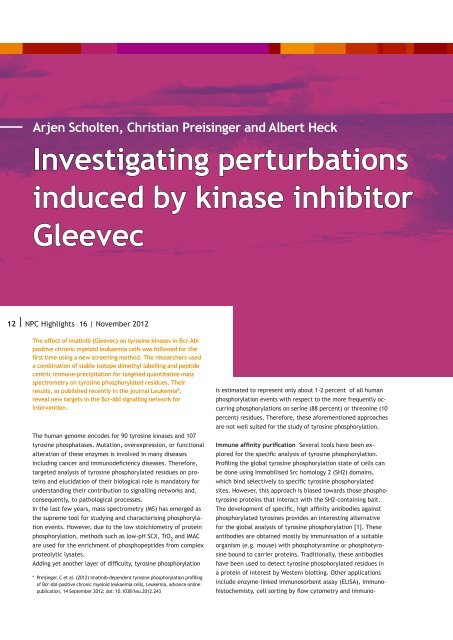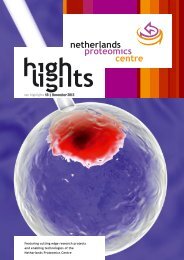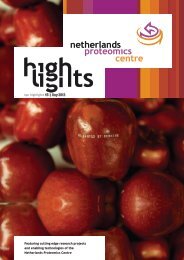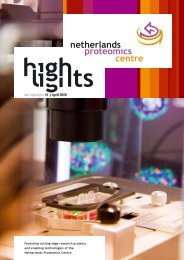Arjen Scholten, Christian Preisinger and Albert HeckInvestigating perturbationsinduced by kinase inhibitorGleevec12 | <strong>NPC</strong> Highlights 16 | November 2012The effect of Imatinib (Gleevec) on tyrosine kinases in Bcr-Ablpositive chronic myeloid leukaemia cells was followed for thefirst time using a new screening method. The researchers useda combination of stable isotope dimethyl labelling and peptidecentric immune-precipitation for targeted quantitative massspectrometry on tyrosine phosphorylated residues. Theirresults, as published recently in the journal Leukemia*,reveal new targets in the Bcr-Abl signalling network forintervention.The human genome encodes for 90 tyrosine kinases and 107tyrosine phosphatases. Mutation, overexpression, or functionalalteration of these enzymes is involved in many diseasesincluding cancer and immunodeficiency diseases. Therefore,targeted analysis of tyrosine phosphorylated residues on proteinsand elucidation of their biological role is mandatory forunderstanding their contribution to signalling networks and,consequently, to pathological processes.In the last few years, mass spectrometry (MS) has emerged asthe supreme tool for studying and characterising phosphorylationevents. However, due to the low stoichiometry of proteinphosphorylation, methods such as low-pH SCX, TiO 2 and IMACare used for the enrichment of phosphopeptides from complexproteolytic lysates.Adding yet another layer of difficulty, tyrosine phosphorylation* Preisinger, C et al. (2012) Imatinib-dependent tyrosine phosphorylation profilingof Bcr-Abl-positive chronic myeloid leukaemia cells, Leukemia, advance onlinepublication, 14 September 2012; doi: 10.1038/leu.2012.243is estimated to represent only about 1-2 percent of all humanphosphorylation events with respect to the more frequently occurringphosphorylations on serine (88 percent) or threonine (10percent) residues. Therefore, these aforementioned approachesare not well suited for the study of tyrosine phosphorylation.Immune affinity purification Several tools have been exploredfor the specific analysis of tyrosine phosphorylation.Profiling the global tyrosine phosphorylation state of cells canbe done using Immobilised Src homology 2 (SH2) domains,which bind selectively to specific tyrosine phosphorylatedsites. However, this approach is biased towards those phosphotyrosineproteins that interact with the SH2-containing bait.The development of specific, high affinity antibodies againstphosphorylated tyrosines provides an interesting alternativefor the global analysis of tyrosine phosphorylation [1]. Theseantibodies are obtained mostly by immunisation of a suitableorganism (e.g. mouse) with phosphotyramine or phosphotyrosinebound to carrier proteins. Traditionally, these antibodieshave been used to detect tyrosine phosphorylated residues ina protein of interest by Western blotting. Other applicationsinclude enzyme-linked immunosorbent assay (ELISA), immunohistochemisty,cell sorting by flow cytometry and immuno-
What this research is about:Advanced tools for in depth research onleukaemia drug effectChronic myeloid leukaemia is characterised by an abnormalincrease in immature white blood cells and it is treated withthe first line drug Imatinib, also known as Gleevec. The drugsuppresses the cell growth and division by inhibiting theresponsible kinase (Bcr-Abl) enzyme that is continuouslyactive due to an acquired mutation. “There is a lot ofknowledge about the drug and how it works on this kinase inthe leukemic cells, but what happens afterwards in the cellis not completely clear,” says Arjen Scholten, assistant professorof the Biomolecular Mass Spectrometry & Protemicsgroup of Utrecht University. “This kinase enzyme bindsspecifically with the amino acid tyrosine and attaches aphosphate label to it. It was not easy till now to detect thisphosphate modified tyrosine using conventional methods,since only a small percentage of all phosphate modificationspresent in the cell are of this specific type.”In this article the authors describe a method that canscreen specifically for these modified tyrosine substratesin leukemic cells. “We show that this tool can give insightinto a whole protein network at the same time. We identifiedapproximately two hundred modified tyrosine proteins,some already known and many new ones,” Scholten says.He picked one of the newly found proteins to study in moredepth in order to demonstrate the potential of this discoverytool.Since patients develop resistance to Imatinib after a certainperiod, other targets in the field of the kinase activity couldbe alternative approaches to circumvent resistance. Scholtenexplains: “Our studied protein might be an interesting targetfor a new drug. But that is long term thinking and not reallyour expertise. We used leukemic cells as a model system togain new insights into how Imatinib influences related proteinsin the leukemic cells. This screening technique can beenormously valuable for understanding biological networks.”| 13<strong>NPC</strong> E2: Chemical Approaches to Proteome Biologyfluorescence. Over the last few years, these antibodies havealso been used for the enrichment of tyrosine phosphorylatedproteins followed by mass spectrometry analysis [2]. However,detection of the actual phosphotyrosine residue is then hamperedby the high presence of unmodified peptides derivedfrom the captured phosphotyrosine modified protein and itsco-purifying binding partners.More recently, the field successfully shifted to the peptidelevel for the immune affinity purification (IAP) of phosphotyrosinepeptides from samples as complex as whole cell lysatedigests [3-5]. Most notably, Rikova et al. applied such an approachto investigate tyrosine kinase signalling across 41 lungcancer cell lines and over 150 tumours [5]. The most importantdifference with the protein level immunoprecipitation isthat this approach allows the identification and localisationof the exact phosphotyrosine residue in the protein on everyidentified protein.Here we describe how we adopted the IAP method to introducea robust and simple procedure that allows the identificationof hundreds of tyrosine phosphorylated residueswithin only 6 hours of mass spectrometry analysis time.When coupled to labelling strategies such as iTRAQ, SILAC ordimethylation (used here), this technique is able to extractbiologically rich quantitative information on tyrosine phosphorylationdriven signalling in differential conditions.Leukaemia and Gleevec The fusion kinase Bcr-Abl is the majorcause and pathogenetic principle of chronic myeloid leukaemia(CML). Bcr-Abl results from a chromosomal translocationthat fuses the bcr and the abl genes, thereby generating aconstitutively active tyrosine kinase, which stimulates severalsignalling networks required for proliferation and survival.Bcr-Abl’s oncogenic properties comprise both a kinase and ascaffold protein. A number of Bcr-Abl interaction partners anddownstream effectors have been described, improving ourunderstanding of the signalling networks deranged in CML. The‘core-interactome of Bcr-Abl’ entails seven major interactionpartners: GRB2, Shc1, Crk-l, c-Cbl, p85, Sts-1, and SHIP2 [6](see Figure 2).The introduction of the Bcr-Abl tyrosine kinase inhibitor (TKI)Imatinib (Gleevec) has been a landmark in the treatment ofCML. However, the development of Imatinib resistance poseschallenges to the clinical management of CML, and althoughsecond generation TKIs can block many Imatinib resistantmutants, they are ineffective against the common T315Imutation. An alternative strategy is to circumvent Imatinib






